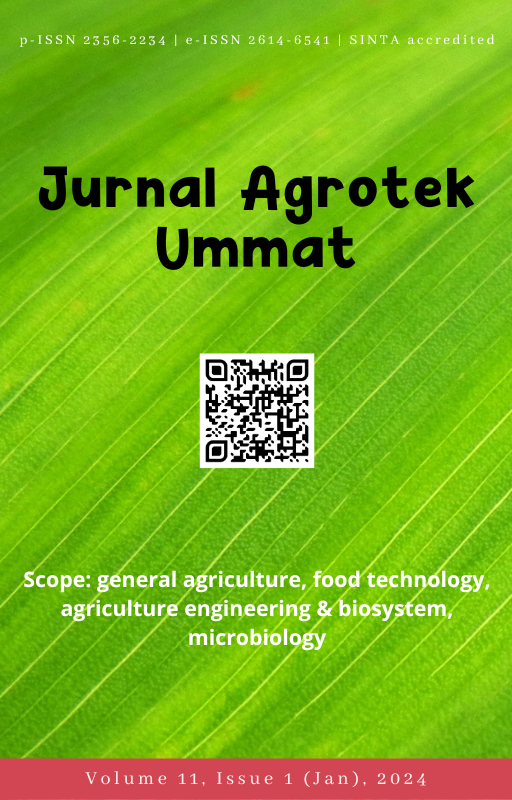Sensory quality of cookies made from chickpea flour (Phaseolus vulgaris L.) and mocaf as non-gluten snacks
DOI:
https://doi.org/10.31764/jau.v11i1.20531Keywords:
chickpea flour, cookies, mocaf, non-gluten, snacksAbstract
Cookies are high-fat snacks made from soft dough that have a relatively crunchy texture and a solid cut shape. In an effort to reduce the use of unhealthy wheat flour, cookies can be made from other flours such as chickpea flour and mocaf flour (from cassava). The purpose of this study was to determine the sensory characteristics of cookies from the formulation of two different types of flour (chickpea and mocaf). This study used a completely randomised design (CRD), with 6 treatments, namely: K0 = 0% chickpea flour: Mocaf 100%, K1 = Chickpea Flour 15%: Mocaf 85%, K2 = Chickpea Flour 30%: Mocaf 70%, K3 = Chickpea Flour 45%: Mocaf 55%, K4 = Chickpea Flour 60%: Mocaf 40% and K5 = Chickpea Flour 75%: Mocaf 15%. The results were analysed using analysis of variance (ANOVA) using Microsoft Excel and IBM SPSS Statistics 25.0 applications. If different data was obtained, it was further analysed using BNJ (Differential Real Honest) at the 5% significance level. Based on the results of data analysis, it is known that mixing chickpea flour and mocaf as raw material for cookies has a significant effect on all organoleptic parameters, both Skoring and hedonic methods. Where, the more the addition of chickpea flour and the less mocaf flour, all organoleptic parameters show a tendency of lower values. In conclusion, treatment K0 is the most preferred formulation by the panelists with the Skoring criteria of very yellow colour, very tasteless chickpea flavour and very non-crispy texture. The hedonic criteria for colour and flavour were highly preferred, while texture was preferred.
References
Anova, I. T., Hermianti, W., dan Silfia. (2014). Substitusi Tepung Terigu dengan Tepung Kentang (Solanum sp) pada pembuatan Cookies Kentang. Jurnal Litbang Industri, 4(2), 123–131.
Aprilia, N. P. R. ., Yusa, N. ., dan Pratiwi, I. D. P. (2019). Perbandingan Modified Cassava Flour (Mocaf) dengan Tepung Kacang Hijau (Vigna radiate. L) terhadap Karakteristik Sponge Cake. Jurnal Ilmu dan Teknologi Pangan, 8(2), 171–180.
Ariani, L. ., Estiasih, T., dan Martati, E. (2017). Karakteristik Sifat Fisiko Kimia Ubi Kayu Berbasis Kadar Sianida. Jurnal Teknologi Pertanian, 18(2), 119–128.
Cicilia, S., Basuki, E., Alamsyah, A., Yasa, I. W. ., Dwikasari, L. ., dan Suari, R. (2021). Sifat Fisik dan Daya Terima Cookies dari Tepung Biji Nangka Dimodifikasi. Prosiding saintek LPPM Universitas Mataram, 3(1), 612–621.
Dandachy, S., Mawlawi, H., dan Obeid, O. (2019). Effect of processed chickpea flour incorporation on sensory properties of mankoushe Zaatar. 8(5), 151–160.
Djafar, C. F. ., Naiu, A. ., dan Mile, L. (2021). Tingkat Kesukaan dan Karakteristik Mutu Produk Rempeyek Berbahan Dasar Ikan Teri Jengki Kering. Jurnal Ilmiah Perikanan dan Kelautan, 10(1), 40–47.
Edwards, C., Veerabahu, A.., Mason, A ., Butterworth, P., dan Ellis, P. (2021). α-amylase Action on Starch in Chickpea Flour following Hydrothermal Processing and Different Drying, Cooling, and Storage Conditions. Elsevier, 259(1), 1–9.
Garnida, Y. (2020). Uji Indrawi dan Sensori pada Industri Pangan. Manggu.
Grasso, N., Lynch, N., Arendt, E., dan O’mahony, J. (2021). Chickpea protein ingredients: A review of composition, functionality, and aplications. Food science and food safety, 21(1), 435–452.
Gusriani, I., Koto, H., dan Dany, Y. (2021). Aplikasi Pemanfaatan Tepung Mocaf (Modified Cassava Flour) pada Beberapa Produk Pangan di Madrasah Aliyah Mambaul Ulum Kabupaten Bengkulu Tengah. Jurnal Inovasi Pengabdian Masyarakat Pendidikan, 2(1), 57–73.
Ihromi, S., Marianah, dan Susandi, Y. . (2018). Subsitusi Tepung Terigu Dengan Tepung Mocaf dalam Pembuatan Kue Kering. Jurnal Agrotek UMMAT, 5(1), 73–77.
Lu, L., He, C., Liu, B., Wen, Q., dan Xia, S. (2022). Incorporation of Chickpea Flour into Biscuits Improves The Physicochemical Properties and in vitro Starch Digestibility. Elsevier, 159(1), 1–8.
Noordraven, L. E ., Jung, K., Hoogland, H., Grauwet, T., dan Loey, A. M. (2021). Potential of chickpea flours with different microstructures as multifunctional ingredient in an instant soup application. Foods, 10(11), 1–18.
Novrini, S. (2020). Pengaruh persentase tepung sukun dalam campuran tepung dan gula terhadap mutu cookies sukun. AGRILAND Jurnal Ilmu Pertanian, 8(1), 61–65.
Rahman, M. H. ., Ariani, R. ., dan Masdarini, L. (2021). Substitusi Penggunaan Tepung Mocaf (Modified Cassava Flour) Pada Butter Cookies Kelapa. Jurnal Kuliner, 1(2), 89–97.
Rina, O., Dharma, A., dan Afrizal. (2021). Potensi Keberadaan Senyawa Akrilamida dalam Makanan. Jurnal Analis Farmasi, 6(2), 109–113.
Rosida, D., Putri, N., dan Oktafiani, M. (2020). Karakteristik Cookies Tepung Kimpul Termodifikasi (Xanthosoma sagittifolium) dengan Penambahan Tapioka. Jurnal Agrointek, 14(1), 45–56.
Sariani, A., Suranadi, L., dan Sofiyatin, R. (2019). Pengaruh Substitusi Tepung Kedelai (Glyine max L.) terhadap Sifat Organoleptik Soybeans Cookies. Jurnal Gizi Prima, 4(1), 1–7.
Wallace, T. ., Murray, R., dan Zelman, K. . (2016). The nutritional value and health benefits of chickpeas and hummus. Nutrients, 8(12), 766–776.
Widodo, S., dan Sirajuddin, S. (2017). Biscuit Formulation with Addition of Mozambique Tilapia Fish, Round Sardinella Fish and Brown Rice Flour. Journal of Science and Research, 6(8), 1699–1704.
Downloads
Published
Issue
Section
License
Authors who publish articles in Jurnal Agrotek Ummatagree to the following terms:- Authors retain copyright of the article and grant the journal right of first publication with the work simultaneously licensed under a CC-BY-SA or The Creative Commons Attribution–ShareAlike License.
- Authors are able to enter into separate, additional contractual arrangements for the non-exclusive distribution of the journal's published version of the work (e.g., post it to an institutional repository or publish it in a book), with an acknowledgment of its initial publication in this journal.
- Authors are permitted and encouraged to post their work online (e.g., in institutional repositories or on their website) prior to and during the submission process, as it can lead to productive exchanges, as well as earlier and greater citation of published work (See The Effect of Open Access).

